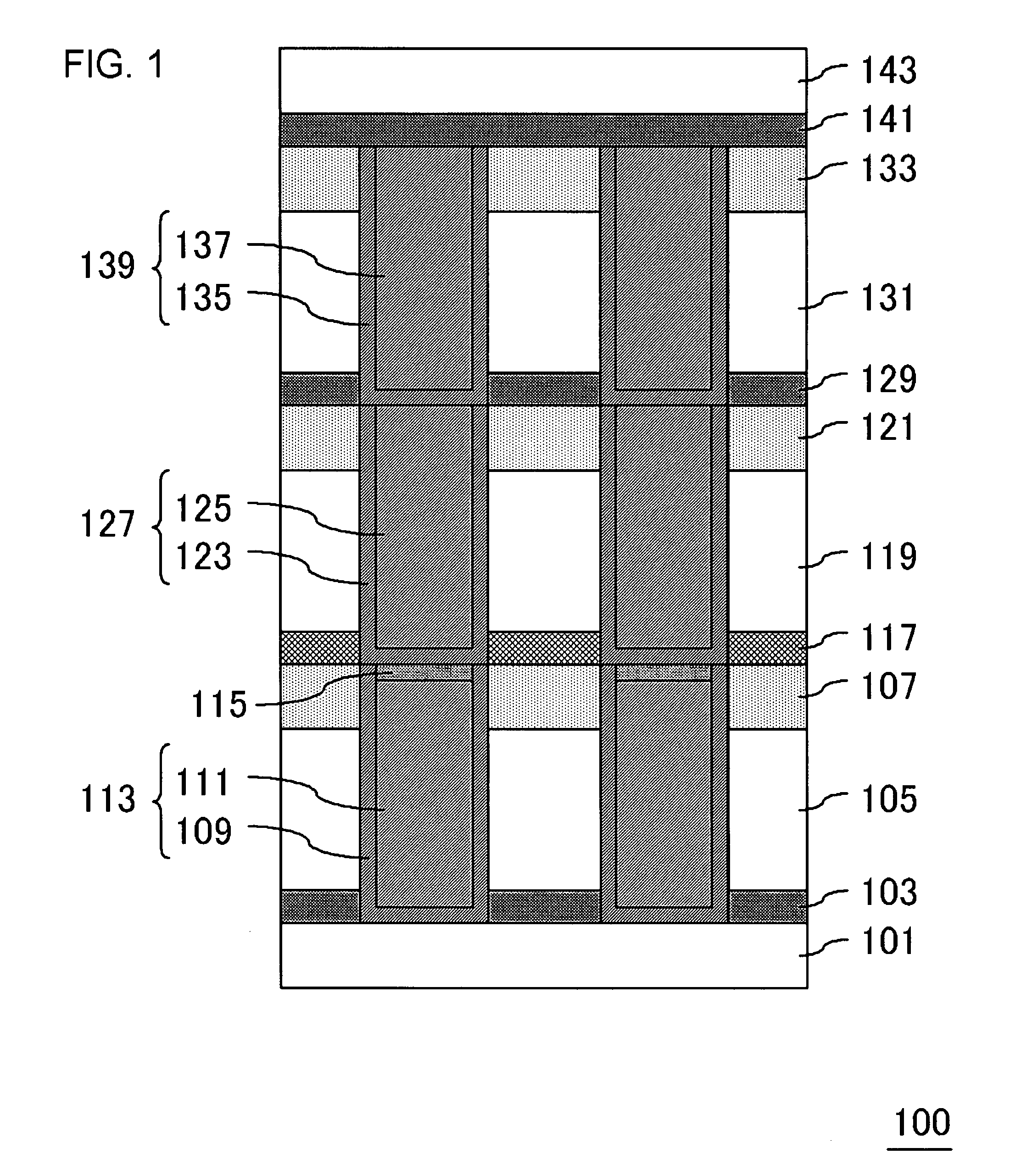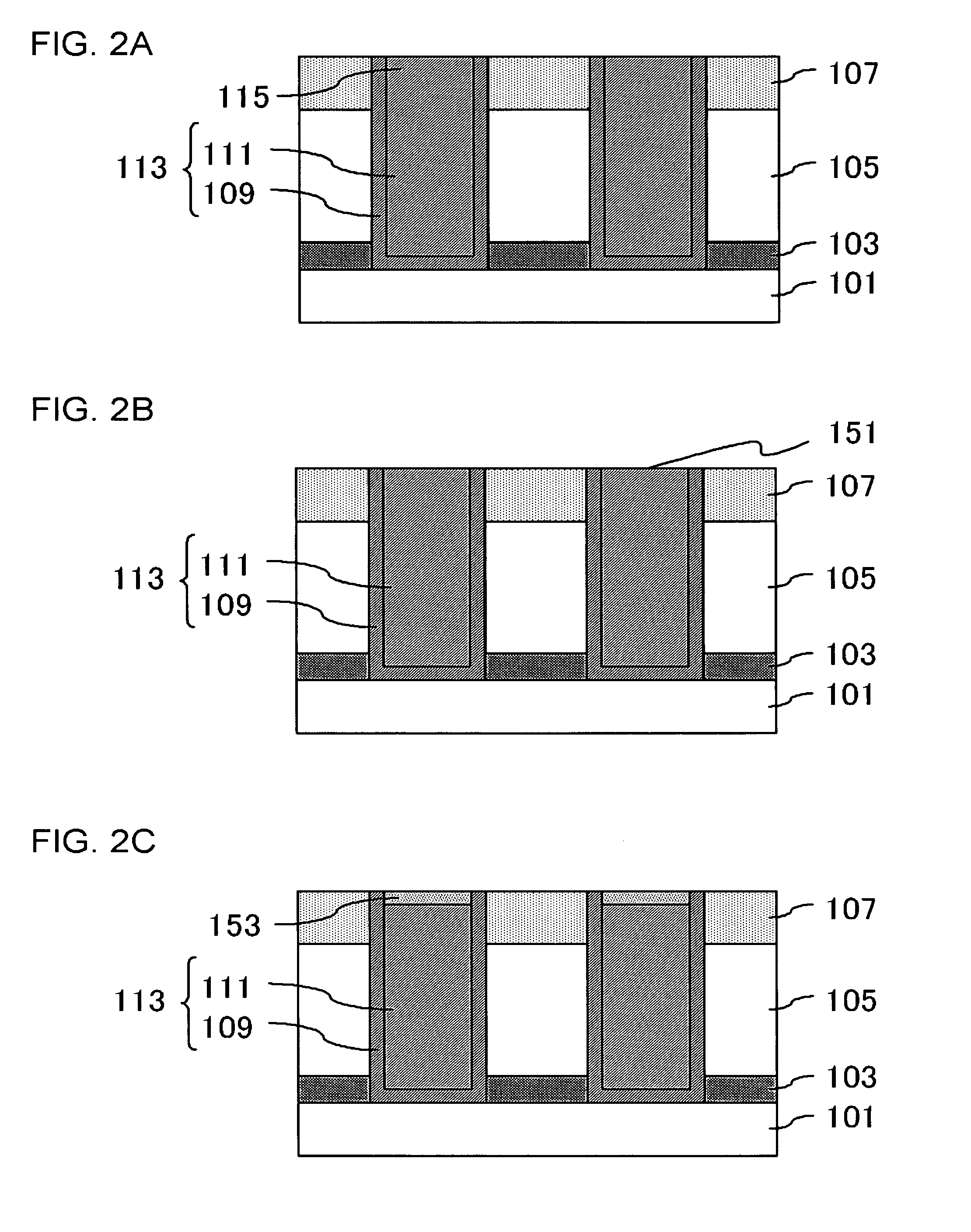Semiconductor device and method for manufacturing same
a technology of semiconductor devices and semiconductor layers, which is applied in the direction of semiconductor devices, semiconductor/solid-state device details, electrical apparatus, etc., can solve the problems of difficult uniform formation of silicide layers having a constant film thickness on the interconnect, deteriorating migration resistance, and increasing the resistance of interconnects, so as to improve electrical resistance, improve migration resistance, and reduce copper
- Summary
- Abstract
- Description
- Claims
- Application Information
AI Technical Summary
Benefits of technology
Problems solved by technology
Method used
Image
Examples
first embodiment
[0047]FIG. 1 is a cross-sectional view, illustrating a configuration of a semiconductor device of the present embodiment. A semiconductor device 100 shown in FIG. 1 includes a substrate such as a semiconductor substrate (a silicon substrate 101), a first insulating film (an SiCN film 103, an SiOC film 105 and an SiO2 film 107) provided on the silicon substrate 101, and an interconnect (a first copper interconnect 111) provided in the first insulating film and essentially composed of a copper-containing metal. Further, the semiconductor device 100 has a region doped with injected silicon (an Si unevenly distributed layer 153 of FIG. 2C) in the vicinity of the surface in the inside of the first copper interconnect 111, and injected atomic silicon at least partially creates Si—O bond (Si—O unevenly distributed layer 115).
[0048]Here, in the following descriptions of the present and the other embodiments, “in the vicinity of the surface of the interconnect in the inside thereof” means in...
second embodiment
[0091]While the SiC film 117 is formed on the first copper interconnect 111 after oxidation of silicon injected in the first copper interconnect 111 is conducted in the first embodiment, the procedure may also be conducted with reverse sequential order. In the present embodiment, a procedure in manufacturing the semiconductor device 100 will be described, which includes: injecting silicon in the first copper interconnect 111, and then first forming the SiC film 117, and thereafter oxidizing silicon injected in the first copper interconnect 111.
[0092]A manufacturing process of the present embodiment includes an operation (step 19) for forming the second insulating film so as to be in contact with the first insulating film having the first copper interconnect 111 formed therein, after the step 14 for injecting silicon and before the step 15 for creating Si—O bond. The second insulating film may be, for example, a film described in the first embodiment. In the present embodiment, the S...
third embodiment
[0098]While the configuration that silicon in the Si unevenly distributed layer 153 forms Si—O bond is illustrated in the first embodiment, silicon in the Si unevenly distributed layer 153 may form Si—O bond or Si—N bond.
[0099]FIG. 5 is a cross-sectional view, illustrating configuration of such type of semiconductor device. Fundamental configurations of the semiconductor device 110 shown in FIG. 5 are similar to that of the semiconductor device 100 shown in FIG. 1, except that silicon injected in the vicinity of the surface in the inside of the first copper interconnect 111 at least partially forms Si—N bond in the semiconductor device 110. Further, in the semiconductor device 110, Si—N bond is present in the vicinity of the surface in the inside of the SiO2 film 107.
[0100]More specifically, in the semiconductor device 110, an Si—O and Si—N unevenly distributed layer 145 is formed in the vicinity of the surface in the inside of the first copper interconnect 111. The Si—O and Si—N un...
PUM
| Property | Measurement | Unit |
|---|---|---|
| thickness | aaaaa | aaaaa |
| specific dielectric constant | aaaaa | aaaaa |
| thickness | aaaaa | aaaaa |
Abstract
Description
Claims
Application Information
 Login to View More
Login to View More - R&D
- Intellectual Property
- Life Sciences
- Materials
- Tech Scout
- Unparalleled Data Quality
- Higher Quality Content
- 60% Fewer Hallucinations
Browse by: Latest US Patents, China's latest patents, Technical Efficacy Thesaurus, Application Domain, Technology Topic, Popular Technical Reports.
© 2025 PatSnap. All rights reserved.Legal|Privacy policy|Modern Slavery Act Transparency Statement|Sitemap|About US| Contact US: help@patsnap.com



